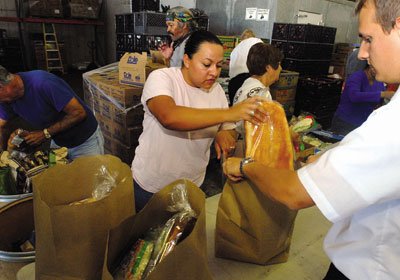With an economy in the doldrums, people just aren’t giving like
they used to. But not giving isn’t an option for nonprofits who
have ever-growing service demands.
With an economy in the doldrums, people just aren’t giving like they used to. But not giving isn’t an option for nonprofits who have ever-growing service demands.
“We have a few clients now who used to be donors,” Community Pantry of San Benito County Executive Director Mary Anne Hughes said. “That for us is very telling.”
Hughes said they expected a growth when the organization moved to a more accessible location in Hollister.
“We anticipated that we would grow 20 percent, or 30 percent with a lot of outreach,” Hughes said. “We’ve increased almost 100 percent.”
Community Pantry used to serve about 800 families a month by doling out weekly bags of food. Now they’re up to 1,400 families some months.
And there’s no end in sight to the stream of needy families arriving at their door, and at the doors of other area nonprofits.
“Our concern is going forward,” she said. The perfect storm – rising gas and food prices, home foreclosures and layoffs – has people “hanging on by the skin of their teeth.” Hughes is worried about what the future will bring, since the charity is already helping families who are trying to hold on to their homes. She wonders what will happen to families like these – and to the charity, which already has stretched resources – if they end up losing their home.
It’s not just families who are in need right now. It’s the groups and volunteers who help them as well.
Gilroy’s Salvation Army, which helps pay some families’ utilities among other services, recently got a seven-day notice to pay its $900 electric bill, according to Capt. Robert Viquez.
“I can’t turn around and ask Salvation Army to pay that,” Viquez said.
Hughes has given five of her volunteers bus tickets so they can get to and from the pantry and deliver food to seniors. They wouldn’t be able to sustain the charitable activity otherwise.
Silicon Valley Community Foundation Donor Engagement and Giving Chief Eleanor Clement Glass said people are still generous, but there are fewer dollars and more in need.
“This is a little different from the downturn of 2001,” she said, referring to the dot-com bust. “A lot more people who are affected are from different populations, seniors desperately needing food, working families, people with earning power not making ends meet because of high cost of gas and food.”
Glass said that times have changed, too – people who are making donations aren’t giving it all to one backyard organization. Local charities have to share the pie with natural disasters, international charitable groups and green issues.
“We thought the situation was bad out there, but it’s even more dire than we thought,” Glass said. “There are these incredible caseloads.”
Glass said the needs go beyond food and shelter. There are also mental health concerns like domestic violence and suicide prevention.
St. Joseph’s Family Center Executive Director David Cox said he’s seen a steady increase in demand for the last 18 months.
“Usually, you can see the light at the end of the tunnel, but it’s been pretty daunting and scary,” he said. “If we’re lucky, funding is stagnant at best.”
Cox said St. Joseph’s, which provides services like meals for families, is lucky because they’ve diversified their funding enough that there’s not been a huge impact but that there are between 30 and 40 new families coming to the food pantry alone each month.
“That’s a pretty good clip,” he said.
And yet, the money to buy food for the newly needy isn’t coming. Donations are down for many organizations. The groups with increased donations use them to fill in gaps from county, state or federal funding losses.
The multi-faceted Morgan Hill service organization Community Solutions has increased donations thanks to increased communication with donors, said director of development Lisa DeSilva. But that doesn’t mean they’re rolling in the dough, she said.
“When the economy goes down, all types of funding are harder to get,” DeSilva said.
Cox said he’s been around for many years at the Salvation Army, and they’ve always received regular mail-in donations.
“But lately, there have been many, many days there’s literally been nothing in the mail,” he said.
Cox said his organization has weathered the storm by dipping into St. Joseph’s reserves, but declined to say by how much. Another way they’ve been getting through the hard time is by cutting back how much food goes to each family.
The situation is the same at the Salvation Army.
“We’re getting 65 people a day for our hot lunch. It was about 40, 45 before,” Viquez said. “When we run out of food, we’ll have to open the fridge and take out bread, start making peanut butter and jelly sandwiches.”
Business closures have affected the charity, too. The Albertsons grocer on Monterey Road in Morgan Hill that closed in 2006 represented one less spot where they can collect money in their small red kettles, Viquez said.
Viquez said he’s cut staff hours to close the gap between overhead and donations. A once full-time cook is now part-time.
“The need is there, I cannot close the doors,” he said. “That would defeat my purpose.”














